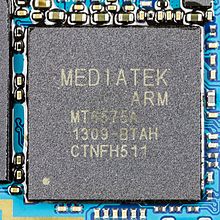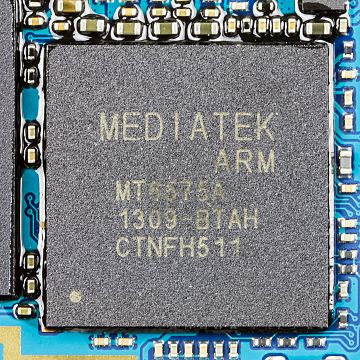The ARM Cortex-A9 MPCore is a 32-bit multi-core processor that provides up to 4 cache-coherent cores, each implementing the ARM v7 architecture instruction set.[1] It was introduced in 2007.[2]
 MediaTek M6575 | |
| General information | |
|---|---|
| Launched | 2007 |
| Designed by | ARM Holdings |
| Performance | |
| Max. CPU clock rate | 0.8 GHz to 2 GHz |
| Cache | |
| L1 cache | 32 KB I, 32 KB D |
| L2 cache | 128 KB–8 MB (configurable with L2sr1 cache controller) |
| Architecture and classification | |
| Instruction set | ARMv7-A |
| Physical specifications | |
| Cores |
|
| History | |
| Predecessor | ARM Cortex-A8 |
| Successor | ARM Cortex-A12 |
Features
Key features of the Cortex-A9 core are:[3]
- Out-of-order speculative issue superscalar execution 8-stage[4] pipeline giving 8.50 DMIPS/MHz/core.
- NEON SIMD instruction set extension performing up to 16 operations per instruction (optional).
- High performance VFPv3 floating point unit doubling the performance of previous ARM FPUs (optional).
- Thumb-2 instruction set encoding reduces the size of programs with little impact on performance.
- TrustZone security extensions.
- Jazelle DBX support for Java execution.
- Jazelle RCT for JIT compilation.
- Program Trace Macrocell and CoreSight Design Kit for non-intrusive tracing of instruction execution.
- L2 cache controller (0–4 MB).
- Multi-core processing.
ARM states that the TSMC 40G hard macro implementation typically operates at 2 GHz; a single core (excluding caches) occupies less than 1.5 mm2 when designed in a TSMC 65 nanometer (nm) generic process[5] and can be clocked at speeds over 1 GHz, consuming less than 250 mW per core.[2]
Chips
This section may contain an excessive amount of intricate detail that may interest only a particular audience. (July 2017) |
Several system on a chip (SoC) devices implement the Cortex-A9 core, including:
- Altera SoC FPGA[6]
- AMLogic AML8726-M[7]
- Apple A5, A5X
- Broadcom BCM11311 (Persona ICE)[8]
- Calxeda EnergyCore ECX-1000[9]
- Entropic EN7588,[10] EN7530
- NXP Semiconductors (Formerly Freescale) QorIQ Layerscape LS1024A[11]
- Freescale Semiconductor i.MX6[12]
- HiSilicon K3V2 -Hi3620[13]
- Marvell Avastar 88W8787, used in the Sony PlayStation Vita[14][15]
- MediaTek MT6575[16] (single core), MT6577[17] (dual core)
- Mindspeed Technologies Mindspeed Comcerto 2000[18][19][20]
- Nufront NuSmart 2816, 2816M, 115[21]
- Nvidia Tegra 2 (without NEON extensions), Tegra 3 and Tegra 4i
- Trident Microsystems 847x/8x/9x SoC family[22]
- Renesas Electronics RZ/A1H, M, L, LU Family
- Samsung Exynos 4210,[23] 4212, 4412, 4415
- Rockchip RK3066,[24] RK292x, RK31xx
- STMicroelectronics SPEAr1310,[25] SPEAr1340[26]
- ST-Ericsson Nova A9500, NovaThor U8500,[27] NovaThor U9500[28]
- Texas Instruments OMAP4 processors
- Texas Instruments Sitara AM437x[29]
- WonderMedia WM8850, WM8950 and WM8980[30]
- Xilinx Extensible Processing Platform[31]
- ZiiLABS ZMS-20[32]
Systems on a chip
| Developer | Name | Cores | Process | NEON SIMD | Vector floating point unit | GPU |
|---|---|---|---|---|---|---|
| Altera | SoC FPGA | 1–2 | 28 nm | Yes | VFPv3 | optionally implemented in FPGA; TES Electronic Solutions D/AVE HD Archived 14 November 2017 at the Wayback Machine |
| Ambarella Inc. | S3L | 1 | 28 nm | Yes | VFPv3 | – |
| AMLogic | AML8726-M | 1 | 65 nm | Yes | VFPv3 | ARM Mali-400 |
| AMLogic | AML8726-MX | 2 | 40 nm | Yes | VFPv3 | ARM Mali-400 MP2 |
| AMLogic | AML8726-M8 | 4 | 28 nm | Yes | VFPv3 | ARM Mali-450 MP6 |
| Apple Inc. | A5 | 2 | 32 nm 45 nm | Yes | VFPv3 | PowerVR SGX543MP2 |
| Apple Inc. | A5X | 2 | 45 nm | Yes | VFPv3 | PowerVR SGX543MP4 |
| Broadcom | BCM11311 (Persona ICE) | 2 | 40 nm | ? | ? | Broadcom Videocore IV |
| Broadcom | BCM21654 | 1 | 40 nm | Yes | VFPv3 | Broadcom Videocore IV |
| Broadcom | BCM21664T | 2 | 40 nm | Yes | VFPv3 | Broadcom Videocore IV |
| Calxeda | EnergyCore ECX-1000[9] | 4 | 40 nm | Yes | VFPv3 | – |
| ELVEES Multicore | 1892VM14Ya | 2 | 40 nm | Yes | VFPv3 | ARM Mali-300 |
| Freescale Semiconductor | i.MX6[33] | 1–4 | 40 nm | Yes | VFPv3-D32 | Vivante Corporation GPU IP cores[34] |
| HiSilicon | K3V2 (Hi3620) | 4 | 40 nm | Yes | VFPv3 | Vivante GC4000 |
| Intel | Cyclone V | 1–2 | 28 nm | Yes | VFPv3 | - |
| LG Corp | LG L9 | 2 | ? | ? | ? | ARM Mali-400 MP4 |
| Marvell | ARMADA 38x | 1–2 | 28 nm | Yes | VFPv3 | - |
| Marvell | PXA986 | 2 | 45 nm | Yes | VFPv3 | PowerVR SGX540 / Vivante GC1000 (Galaxy Tab 3 7-inch) |
| Marvell | PXA988 | 2 | 45 nm | Yes | VFPv3 | Vivante GC1000 |
| MediaTek | MT6575 | 1 | 40 nm | Yes | VFPv3 | PowerVR SGX531[16] |
| MediaTek | MT6577 | 2 | 40 nm | Yes | VFPv3 | PowerVR SGX531[17] |
| Mindspeed Technologies | Comcerto 2000 | 2 | ? | Yes | ? | – |
| Nufront | NuSmartTM 2816(NS2816) | 2 | ? | Yes | VFPv3 | ARM Mali-400[35] |
| Nufront | NuSmartTM 2816M (NS2816M) | 2 | ? | Yes | VFPv3 | ARM Mali-400 |
| Nufront | NuSmartTM 115 (NS115) | 2 | ? | Yes | VFPv3 | ARM Mali-400 |
| Nvidia | Tegra 2 series | 2 | 40 nm | No | VFPv3-D16 | GeForce ULP |
| Nvidia | Tegra 3 (Kal-El) series | 4 | 40 nm | Yes | VFPv3 | GeForce ULP |
| Renesas Electronics | ? | ? | ? | ? | – | |
| Renesas Electronics | RZ/A1H[36] | 1 | various | Yes | VFPv3 |
WXGA 2D graphics 10MByte RAM SoC |
| Renesas Electronics | RZ/A1M[36] | 1 | various | Yes | VFPv3 |
WXGA 2D graphics 5MByte RAM SoC |
| Renesas Electronics | RZ/A1L[36] | 1 | various | Yes | VFPv3 |
WXGA 2D graphics 3MByte RAM SoC |
| Renesas Electronics | RZ/A1LU[36] | 1 | various | Yes | VFPv3 |
RZ/A1L plus Ethernet AVB support and a JPEG codec unit, 3MByte RAM SoC |
| Rockchip | RK2928 | 1 | 40 nm | ? | ? | ARM Mali-400 |
| Rockchip | RK3066[24] | 2 | 40 nm | Yes | VFPv3 | ARM Mali-400 MP4 |
| Rockchip | RK3128 | 2 | ? | Yes | VFPv3 | ARM Mali-400 MP4 |
| Rockchip | RK3188[37] | 4 | 28 nm | Yes | VFPv3 | ARM Mali-400 MP4 |
| Samsung | Exynos 4 Dual (4210) | 2 | 45 nm | Yes | VFPv3 | ARM Mali-400 MP4 |
| Samsung | Exynos 4 Dual (4212) | 2 | 32 nm | Yes | VFPv3 | ARM Mali-400 MP4 |
| Samsung | Exynos 4 Quad (4412) | 4 | 32 nm | Yes | VFPv3 | ARM Mali-400 MP4 |
| Samsung | Exynos 4 Quad (4415) | 4 | 28 nm | Yes | VFPv3 | ARM Mali-400 MP4 |
| STMicroelectronics | SPEAr1310 | ? | ? | No | VFPv3 | – |
| STMicroelectronics | SPEAr1340 | 2 | ? | No | VFPv3-D16 | ARM Mali-200[38] |
| ST-Ericsson | Nova A9500 | 2 | 45 nm | Yes | VFPv3 | ARM Mali-400 |
| ST-Ericsson | NovaThor U8500 | 2 | 45 nm | Yes | VFPv3 | ARM Mali-400 |
| ST-Ericsson | NovaThor U9500 | 2 | 45 nm | Yes | VFPv3 | ARM Mali-400 |
| Sony | PlayStation Vita | 4 | 40 nm | Yes | VFPv3 | PowerVR SGX543MP4+ |
| Texas Instruments | Sitara AM437x | 1 | 45 nm | Yes | VFPv3 | SGX530 Graphics Engine |
| Texas Instruments | OMAP4430 OMAP4460 | 2 | 45 nm | Yes | VFPv3 | PowerVR SGX540 |
| Texas Instruments | OMAP4470 | 2 | 45 nm | Yes | VFPv3 | PowerVR SGX544 |
| Trident Microsystems | PNX8473[39] | 1 | ? | ? | ? | PowerVR SGX531 |
| Trident Microsystems | PNX8483[40] | 1 | ? | ? | ? | PowerVR SGX531 |
| Trident Microsystems | PNX8491[41] | 1 | ? | ? | ? | PowerVR SGX531 |
| WonderMedia | WM8850 | 1 | 40 nm | Yes | VFPv3 | ARM Mali-400 |
| WonderMedia | WM8880 | 2 | 40 nm | ? | ? | ARM Mali-400 MP2 |
| WonderMedia | WM8950 | 1 | 40 nm | ? | ? | ARM Mali-400[30] |
| WonderMedia | WM8980 | 2 | 40 nm | ? | ? | ARM Mali-400 MP2 |
| Xilinx | Zynq-7000[42] | 2 | 28 nm | Yes | VFPv3 | – |
| ZiiLABS | ZMS-20 | ? | ? | Yes | VFPv3 | ZiiLABS flexible Stemcell media processing |
See also
References
External links
Wikiwand in your browser!
Seamless Wikipedia browsing. On steroids.
Every time you click a link to Wikipedia, Wiktionary or Wikiquote in your browser's search results, it will show the modern Wikiwand interface.
Wikiwand extension is a five stars, simple, with minimum permission required to keep your browsing private, safe and transparent.
